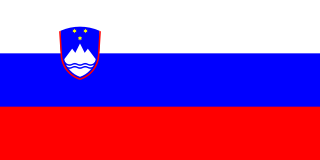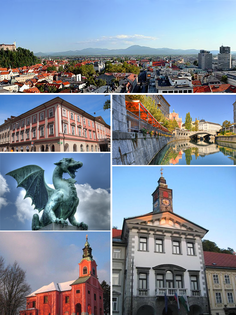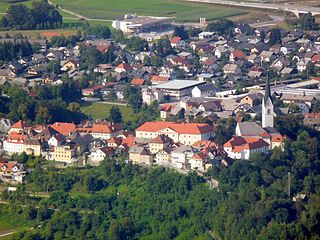
Jože Plečnik was a Slovene architect who had a major impact on the modern architecture of Slovenia, Prague and of Ljubljana, the capital of Slovenia, most notably by designing the iconic Triple Bridge and the Slovene National and University Library building, as well as the embankments along the Ljubljanica River, the Ljubljana open market buildings, the Ljubljana cemetery, parks, plazas etc. His architectural imprint on Ljubljana has been compared to the impact Antoni Gaudí had on Barcelona.
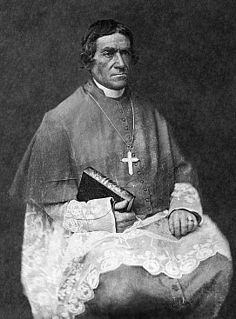
Irenaeus Frederic Baraga was a Slovenian Roman Catholic missionary to the United States and a grammarian of Native American languages. He became the first bishop of the Roman Catholic Diocese of Marquette, Michigan, originally sited at Sault Sainte Marie, which he led for 15 years.

Maximilian Fabiani, commonly known as Max Fabiani was a cosmopolitan trilingual Italian architect and town planner of mixed Italian-Austrian ancestry, born in the village of Kobdilj near Štanjel on the Karst Plateau, County of Gorizia and Gradisca, in present-day Slovenia. Together with Ciril Metod Koch and Ivan Vancaš, he introduced the Vienna Secession style of architecture in Slovenia.
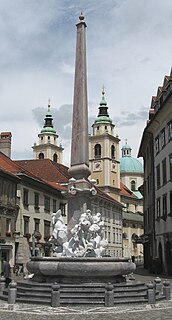
Francesco Robba was an Italian sculptor of the Baroque period. Even though he is regarded as the leading Baroque sculptor of marble statuary in southeastern Central Europe, he has remained practically unknown to international scholars.

Ljubljana Cathedral, officially named St. Nicholas's Church, also named St. Nicholas' Cathedral, the Cathedral of St. Nicholas, or simply the Cathedral, is a cathedral in Ljubljana, the capital of Slovenia. Originally, Ljubljana Cathedral was a Gothic church. In the early 18th century, it was replaced by a Baroque building. It is an easily recognizable landmark of the city with its green dome and twin towers and stands at Cyril and Methodius Square by the nearby Ljubljana Central Market and Town Hall.
The Mladika Complex, the headquarters of the Ministry of Foreign Affairs of the Republic of Slovenia, is a complex of two buildings in the Center District of the capital city of Ljubljana. The first building, at the address 25 Prešeren Street, is L-shaped and stands at the intersection of Prešeren Street and Šubic Street. The other, at the address 11 Šubic Street, stands at the intersection of Šubic Street and Bleiweis Street.

Velike Brusnice is a settlement at the foothills of the Gorjanci range to the east of Novo Mesto in southeastern Slovenia. The entire municipality of Novo Mesto is part of the traditional region of Lower Carniola and is now included in the Southeast Slovenia Statistical Region.

Hlebce is a village in the Municipality of Radovljica in the Upper Carniola region of Slovenia.

Sora is a village in the Municipality of Medvode in the Upper Carniola region of Slovenia. It includes the hamlets of Farjevec and Komarnija.

Leskovec pri Krškem is a settlement on the right bank of the Sava River in the Municipality of Krško in eastern Slovenia. The area was traditionally part of Lower Carniola. It is now included with the rest of the municipality in the Lower Sava Statistical Region. It includes the hamlets of Grad, Beli Breg, Veliki Marof, and Žadovinka. Older sources also mention the appertaining hamlet of Bajer.
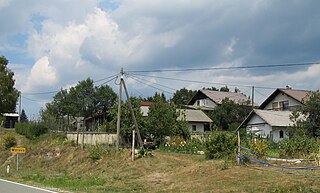
Morava is a village in the Municipality of Kočevje in southern Slovenia. It was a village settled by Gottschee Germans. During the Second World War its original population was expelled. The area is part of the traditional region of Lower Carniola and is now included in the Southeast Slovenia Statistical Region. It includes the former hamlet of Mošenik.

Javor is a settlement in central Slovenia. It lies in the hills east of the capital Ljubljana and belongs to the City Municipality of Ljubljana. It was part of the traditional region of Lower Carniola and is now included, with the rest of the municipality, in the Central Slovenia Statistical Region. In addition to the main settlement, it also includes the hamlets of Brezovar, Lanišče, Roje, Žagarski Vrh, Zavrharji, and Sevšek.

Gabrovka is a settlement in the Municipality of Litija in central Slovenia. Traditionally the area was part of the Lower Carniola region. It is now included with the rest of the municipality in the Central Sava Statistical Region; until January 2014 the municipality was part of the Central Slovenia Statistical Region. In addition to the center of the settlement, formerly known as Sveti Križ pri Litiji, it includes the hamlets of Orešje, Pretržje, and Trzne.

Polšnik is a settlement in the Municipality of Litija in central Slovenia. Traditionally the area was part of Lower Carniola and is now included with the rest of the municipality in the Central Sava Statistical Region. Together with the two parts of the main settlement it also includes the hamlets of Na Puši, Seruč, Koprivnik, Slop, Glinjek, Velika Njiva, and Sušje.

Videm is a village in the Municipality of Dobrepolje in Slovenia. It is the administrative centre of the municipality. The area is part of the historical region of Lower Carniola. The municipality is now included in the Central Slovenia Statistical Region. Videm consists of two hamlets: Mali Videm is the core of the settlement around Holy Cross Church, and Veliki Videm is located to the northwest, along the road toward Predstruge.
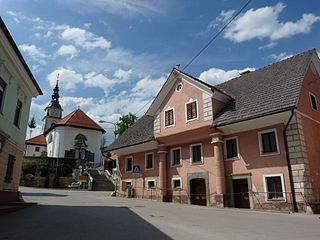
Šentvid pri Stični is a settlement in the Municipality of Ivančna Gorica in central Slovenia. The area is part of the historical region of Lower Carniola. The municipality is now included in the Central Slovenia Statistical Region. In addition to the sections of the main settlement known as Stari Trg and Zadolžna Vas, it includes the hamlets of Travnik, Sveti Rok, Omotce, Postaja Šentvid, and Marof.

Gradišče, officially Gradišče - K. o. Grad. in Polj., is a small settlement in the Municipality of Šmartno pri Litiji in central Slovenia. The area is part of the historical region of Lower Carniola. The municipality is now included in the Central Slovenia Statistical Region. It includes the hamlets of Kremenjek and Primskova Gora.

Josip Vancaš was an Austro-Hungarian and Yugoslav architect who spent most of his career in the Bosnian city of Sarajevo, where he designed over two hundred buildings. He also designed important buildings in present-day Croatia and Slovenia. He was also the first conductor of the Männergesangverein in Sarajevo, at its founding in 1887.

Lambert Ehrlich was a Slovenian Roman Catholic priest, political figure, and ethnologist.

Johann Gregor Thalnitscher von Thalberg was a Carniolan lawyer, scholar of ancient inscriptions, chronicler, and historian.


